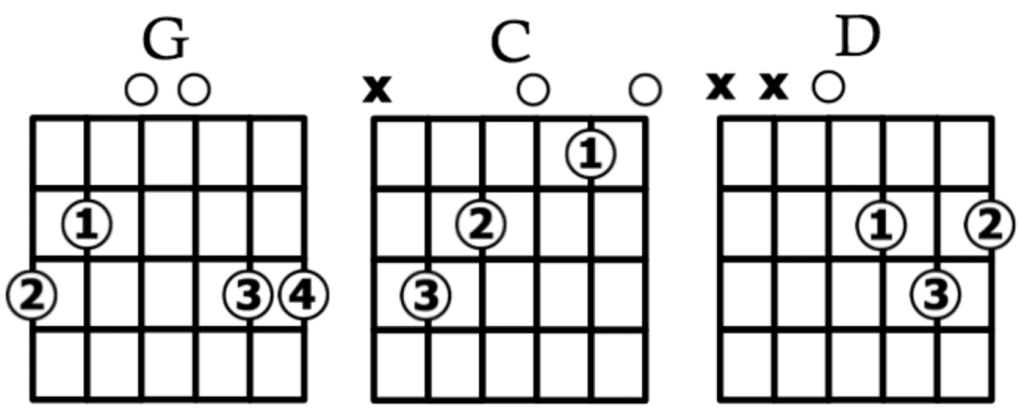Want to play hundreds of songs with just three chords? G, C, and D are quite possibly the three most important chords you'll ever learn as a beginner guitar player.
These three chords work together perfectly because they're the I, IV, and V chords in the key of G major - the foundation of countless rock, pop, country, and folk songs. Once you master these three chords (and learn how to use a capo), nothing will be out of reach for you.
Let me show you how to play them.
What Makes G, C, and D So Special?
These three chords are the I, IV, and V chords in the key of G major. That might sound like theory jargon, but here's what it means in practice: they're the foundation of the most common chord progression in popular music.
Rock, country, folk, blues - you name it. If you can play G, C, and D smoothly, you can play literally hundreds of songs. And once you understand this pattern, you can transpose it to any key using a capo.
Here are the three chords:

Learn these well, my friend. Dream of them when you sleep at night.
With just these three chords, you can play dozens of classic songs - especially once you understand how a capo works. Many songs that aren't originally in the key of G can be played with G, C, and D by simply placing a capo on the right fret.
If you're not familiar with capos yet, check out How to Use a Guitar Capo.
20 Classic Songs Using G, C, D Chords
The links to the songs go to YouTube, so you can hear what they sound like. Just a note though – sometimes recordings of older songs aren't quite in tune, due to differences in recording techniques back then.
No Capo Needed:
Songs Using G, C, and D Chords WITH a Capo:
That list of G-C-D songs ought to keep you busy for a while – but just think what the possibilities are like once we start adding more chords!
Tips for Switching Between G, C, and D Chords
The hardest part for most beginners isn't playing these chords – it's switching between them smoothly. Here are a few tips that'll help:
In general, when you're working on chord changes, look for any fingers that can stay where they are. In other words - are there any shared notes between the chords you're changing between? If there are, AND you use the same finger to play them, then work on keeping that finger in place while you pivot the others around it.
D to G: This is a good example - your 3rd finger (ring finger) can stay where it is and you can use it as an anchor point as you move the rest of your fingers.
That said, sometimes you just need to lift all your fingers off the strings and reposition your hand.
The real secret is to practice the transitions, not just the chords themselves. Set a metronome to a slow tempo and practice switching every four beats. Speed comes later – smooth changes come first.
Want to Go Deeper?
If you're ready to understand WHY these chords work together and unlock this pattern in every key, check out Guitar Theory Unlocked. You'll learn the I-IV-V system that opens up the entire fretboard – so instead of memorizing songs, you'll understand the patterns behind them.
Once you master G-C-D and learn how chord progressions work, you'll be able to play in any key and even write your own progressions.
Frequently Asked Questions
Q: What are the easiest 3-chord songs on guitar?
A: The easiest 3-chord songs use G, C, and D chords. Examples include "Leaving on a Jet Plane," "Brown Eyed Girl," and "Sweet Home Alabama." These songs use the I-IV-V progression in the key of G, which is one of the most common chord patterns in popular music.
Q: Can you play songs with just G, C, and D chords?
A: Yes! Hundreds of songs can be played with just G, C, and D chords, including classics from artists like Bob Dylan, John Denver, and Van Morrison. With a capo, you can play even more songs by transposing these three chords to different keys.
Q: Why do G, C, and D chords work together?
A: G, C, and D are the I, IV, and V chords in the key of G major. This is the most common chord progression in Western music, appearing in rock, country, folk, and pop songs. The chords naturally resolve to each other, creating familiar and pleasing sound patterns.
Q: What's the best order to learn guitar chords?
A: Start with G, C, and D - these three chords give you access to hundreds of songs immediately. After mastering these, add Em, Am, and A to expand your repertoire even further.
Q: How long does it take to learn G, C, and D chords?
A: Most beginners can learn the finger positions for G, C, and D chords in a few days. Switching between them smoothly takes 2-4 weeks of daily practice. The key is practicing the transitions, not just the individual chord shapes.


I love all of these songs and I tried them all. They are all really easy and they sound really cool when you play them. I would recommend Sweet Child O’ Mine by Guns And Roses, it sounds cool and it has a great flow to it.
I want to learn to play the guitar for beginners